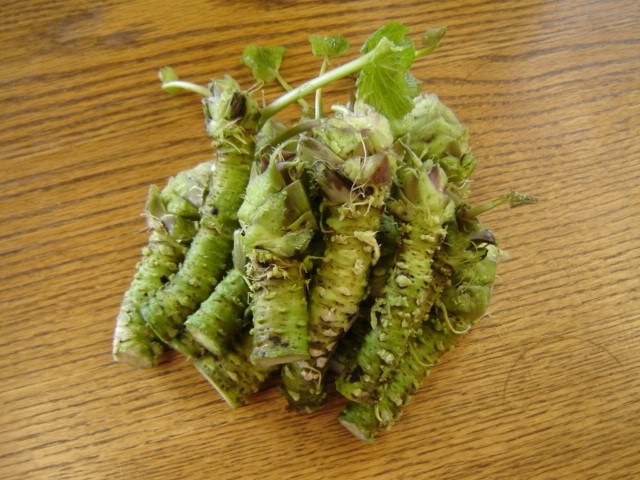
Found as a green, spicy, paste on sushi plates across the country, wasabi (Wasabia japonica or Eutrema japonicum) is a plant of the Brassicaceae. This genus includes other pungent foods such as cabbage, horseradish and mustard. The wasabi plant consists of large, heart shaped leaves, a rhizome (am edible, root-like stem) and delicate white flowers which bloom in early spring.

It might come as a surprise (as it did to me) that the paste on your plate is likely not wasabi but a mixture of horseradish, mustard, starch and green food colouring. Wasabi is expensive due to difficulties in cultivation so substitutions occur often. For one kilogram of this lucrative crop at wholesale it would cost you $160.
Although wasabi is able to be grown in a few select regions around the world such as British Columbia, it is primarily cultivated in Japan. These plants are difficult to grow because they thrive best in running water. Wasabi cultivated for culinary purposes are grown in semi-aquatic conditions called Sawa. It is considered higher quality due the larger rhizomes. In contrast, wasabi grown in fields are called Oka, which are cultivated for nutraceutical purposes, such as herbal supplements.
The Flavour Difference Between Wasabi and Horseradish
Although horseradish is used as a replacement for wasabi the two have noticeable differences in flavour. Wasabi has a more complex vegetable flavour with floral components and a little sweetness. It is herbal and the heat you are accustomed to from horseradish is not as strong.
What is Responsible for the Sinus Burn
Both horseradish and wasabi contain thioglucosides, a sulphur-containing sugar glucose. When you grate wasabi the cell wall releases thioglucosides and an enzyme known as myrosinase. Myrosinase breaks down the thioglucosides into isothiocyanates. The amounts and structure of isothiocyanates vary with in horseradish and wasabi.
The reason wasabi has an initial pungency is largely caused by the volatile compound allyl isothiocyanate (AITC). However, you might notice that this burn is short lived when compared to the effects of chilli peppers. This is because inhaling AITC stimulates the nasal passages and can easily go away with other food and drink. In contrast, hot peppers contain capsaicin, an oil based molecule which stimulates the tongue. The only way to eliminate this is to consume other oil or fat based products.

How to Properly Use Wasabi
If you are able to obtain fresh wasabi, the ideal tool to use on it is a sharkskin grater, which consists of a small wooden paddle with sharkskin affixed to one side. Similar to ginger, slice a small end of the rhizome and remove the outer “skin” with a knife or vegetable peeler. Then using the grater, move the wasabi in a circular direction to produce a fine textured “paste.” It is important that it is used sparingly and within 15 minutes in order to prevent the wasabi from losing its flavour.

Sign Up For Our Weekly 5 Course Meal
I pick out 5 pieces of content from the latest food industry news to the greatest new products and leave my snarky comments every week.
Possible Unique Flavour Combinations
- Wasabi and Maple- Maple pairs well with salmon so it is not surprising that it would also pair well with wasabi. Medium coloured maple syrup has caramel notes which complement the pungency of wasabi. Think of it as the distant cousin to honey-mustard.
- Wasabi and Chocolate- Not for the faint of heart. Immediately, the wasabis volatile components start by creating a spicy taste. The chocolate provides a sweet, creamy flavour which offsets the wasabi. Milk and dark chocolates are best used in this combination depending you preference of sweetness.
- Wasabi and Sour Cream- Sour cream has a slight tang, subtle sweetness and creamy flavour which is able to offset the heat of the wasabi. The two pair well to create a quick sauce which complements a steak dish.
Sources
Phung, A. C. (2014, May 05). Wasabi. Retrieved from https://scienceandfooducla.wordpress.com/2014/04/15/wasabi/
Welcome to Pacific Coast Wasabi Ltd. (n.d.). Retrieved May 01, 2017, from http://www.wasabia.com/
